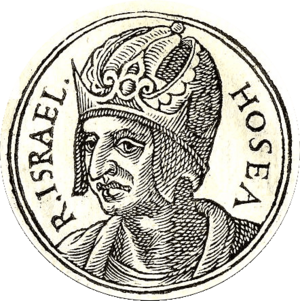Hoshea facts for kids
Quick facts for kids Hoshea |
|
|---|---|
| King Of Israel | |

Hoshea from "Guillaume Rouillé's Promptuarii Iconum Insigniorum
|
|
| King of Northern Israel | |
| Reign | c. 732 – c. 722 BC |
| Predecessor | Pekah |
| Successor | Monarchy abolished |
| Born | c. 759 BC |
| Died | c. 722 BC (aged c. 36) |
| Father | Elah |
Hoshea was the nineteenth and last king of the northern Kingdom of Israel. His name means "salvation." He was the son of a man named Elah. Historians believe he ruled from about 732 BC to 722 BC. His time as king was very important because it marked the end of the northern Kingdom of Israel.
Contents
How Hoshea Became King
Ancient records from Assyria tell us how Hoshea became king. Before Hoshea, the king of Judah, named Ahaz, had become a loyal friend to Tiglath-Pileser III, the powerful king of Assyria. At that time, the northern Kingdom of Israel was ruled by Pekah. Pekah had joined forces with Rezin, the king of Aram-Damascus. They tried to force Judah to join them against Assyria.
Hoshea was a leader in Pekah's army. He supported the Assyrian side in Samaria, which was Israel's capital. Hoshea took power after Pekah was killed. King Tiglath-Pileser III of Assyria then made Hoshea the new king over the northern kingdom. This kingdom had become smaller by then.
An old inscription from Tiglath-Pileser III proudly says that he made Hoshea king after the previous king was overthrown. It mentions that he received a lot of gold and silver as payment from them. This payment was a kind of tax or tribute to Assyria.
Hoshea's Reign and the End of Israel
As long as Tiglath-Pileser III was king of Assyria, Hoshea remained loyal. He paid the required tribute. But when Shalmaneser V became the new Assyrian king, Hoshea tried to become independent. He stopped paying tribute to Assyria. Hoshea also started talking with Osorkon IV, the king of Egypt, hoping for help.
Shalmaneser V saw this as a rebellion. He sent his armies to attack Samaria, the capital of Israel. Assyrian records show that Shalmaneser campaigned against the region for several years. The city of Samaria was attacked and surrounded.
It is thought that Hoshea tried to make peace by offering to pay tribute again. But the Assyrians did not trust him. He was captured during a battle. Even without their king, the people of Samaria fought bravely. They defended their city for three years.
Finally, the Assyrians captured Samaria. This happened around 722 BC. King Shalmaneser V died soon after the city fell. The Assyrian army had to return home to make sure the next king, Sargon II, took power smoothly.
However, the land of Israel, which had fought for years without a king, rebelled again. So, Sargon II returned with the Assyrian army in 720 BC. He completely conquered the kingdom. Many people from Israel were taken away from their homes and moved to lands far away, beyond the Euphrates River. About 27,290 people were moved. People from other places like Babylon and Hamath were brought to live in Israel instead.
The ancient Books of Kings say that this destruction happened because the people of Israel had sinned against the Lord. What happened to King Hoshea after the kingdom fell is not known. No one knows when or where he died.
Seal of Hoshea's Servant
In the 1990s, a small clay seal called a bulla was found. Experts believe it dates back to the 8th century BC. The writing on the seal says, "Belonging to Abdi, servant of Hoshea."
If this seal is real, it is a very important discovery. It would be the only archaeological proof of King Hoshea found so far in an Israelite inscription. It helps us learn more about his time.
See also
- List of biblical figures identified in extra-biblical sources
- So, possibly Osorkon IV

